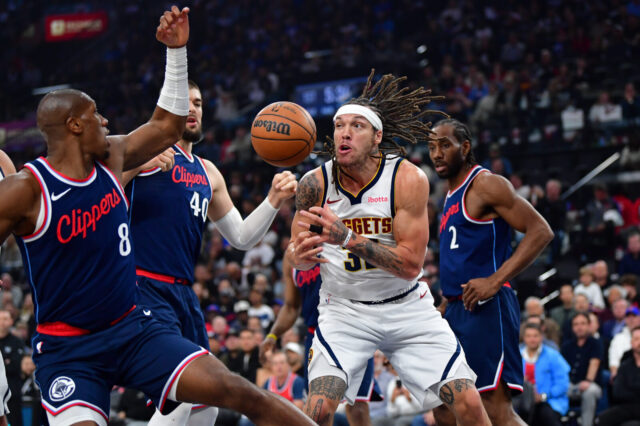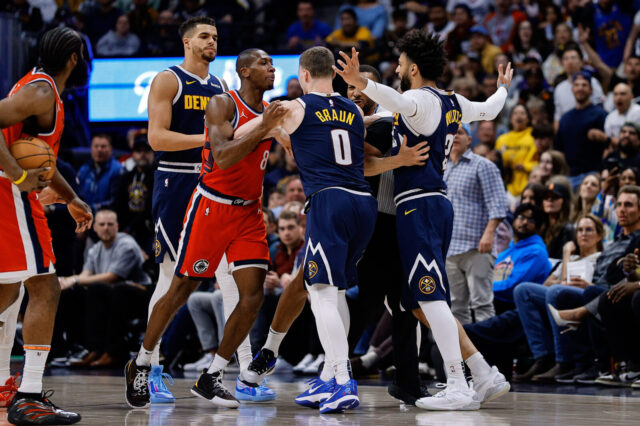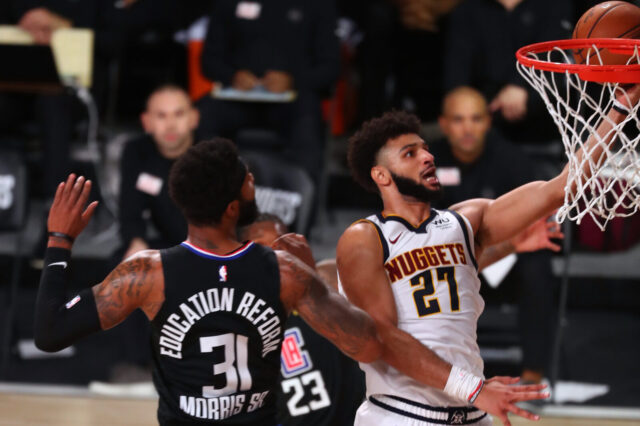This is the beginning of Stat of the Week for the year. SOTW will run every Friday (with a few exceptions here or there) and will be a shorter column. Most of my work (Ryan Blackburn) will take place in a longer editorial piece on Tuesdays. SOTW is a time to share interesting statistics, analytics, and numerical think pieces in less than 1,000 words. Each week, a topic will be selected from either something I want to discuss or something readers would like discussed. You can find me in the comments or on Twitter to discuss these ideas, and I will be more than willing to hold a dialogue.
Up first, the concept of self-creation and why the Nuggets chose to move away from it when Nikola Jokic was inserted into the starting lineup.
Stat of the Week: Efficiency of Self-Creation
Ian Levy (found on Twitter @HickoryHigh) of Nylon Calculus and The Step Back wrote a nice article about the effect of Gordon Hayward and Kyrie Irving on the Boston Celtics, now that Isaiah Thomas, Avery Bradley, Jae Crowder, and other contributors are gone. That piece can be found here. He compared the effective field goal percentage (eFG%) and the percentage of made field goals that were unassisted (% FGM Unassisted) of the old and new look Celtics. The goal of the exercise was to see how much change the Celtics would need to undergo to tend to their new cast of characters.
I decided to do something similar with the Denver Nuggets. Danilo Gallinari was a major factor in the offense last season, but now that he has been replaced by Paul Millsap, Denver has some new questions. Gallinari was an efficient scorer last year, one of the best in the NBA on medium usage, and now he’s being replaced by Millsap, who’s more of a defender than a scorer. How will this affect the Nuggets offense? Will Jamal Murray starting at point guard have a positive or negative impact?
Some of those questions will be answered at another time, but let’s start with Gallinari’s offensive style. He was relatively efficient, combining spot-ups, cuts, and transition opportunities with pick and rolls, post ups, and isolations. The last three play types are generally considered “self-creation” plays, where the scorer does most of the work to put the ball in the basket. Gallinari was one of the more efficient self-creation players in the NBA last year. Millsap was not.
| Play Type | Gallinari frequency (% of plays) | Millsap frequency (% of plays) | Gallinari efficiency (PPP) | Millsap efficiency (PPP) |
|---|---|---|---|---|
| Pick and Roll handler | 10.6 | 1.6 | 1.06 | 0.57 |
| Post Up | 11.5 | 16.9 | 1.20 | 1.00 |
| Isolation | 12.8 | 12.5 | 0.97 | 0.93 |
The difference is drastic in one of the three categories: pick and rolls as the ball handler. Handling the ball in the pick and roll hasn’t been a part of Millsap’s game, as versatile of a player as he is on both offense and defense. Where he makes up the volume is in post up frequency, but Gallinari was the most efficient scorer from the post in the NBA last season among players who averaged one post up possession per game. Jokic was third in the NBA in efficiency. Millsap was ninth, and his volume will make up the difference in efficiency in that category, but pick and rolls are another story.
The pick and roll has become a staple in today’s NBA playbook. Gone are the traditional post ups and isolations of years past. The spread pick and roll is the bread and butter play when things break down. This has been made possible by the Golden Era of point guards in the NBA today, with players like Russell Westbrook, Stephen Curry, Chris Paul, and even Kyrie Irving leading the charge.
The Nuggets don’t have that luxury. Unless Jamal Murray or Emmanuel Mudiay (or Gary Harris possibly) turns into an elite creator overnight, the Nuggets will be one of the few aspiring playoff teams without one. Here’s how each member of the Nuggets stacks up in self-creation:
This content is no longer available.
Every team features different groupings of players, but most of the time, they can be found in distinct categories: inefficient to average creators, efficient finishers, and a little bit of both. The Nuggets are lucky to have two players among the top 25 in eFG% (minimum 40 games and 1,000 minutes played): Nikola Jokic and Gary Harris. Other teams are:
- Cleveland Cavaliers (Kyle Korver, LeBron James, and Channing Frye)
- Golden State Warriors (Andre Iguodala, Kevin Durant)
- Houston Rockets (Montrezl Harrell, Clint Capela, Nene)
- San Antonio Spurs (Dewayne Dedmon, David Lee)
- Utah Jazz (Rudy Gobert, Joe Ingles)
- Washington Wizards (Otto Porter, Jason Smith)
I would categorize all but two of these players to be finishers, the only creators being James and Durant. Even Durant is borderline, though he would probably still make this list as a member of the Thunder, a team where he would be asked to self-create more.
Further down this list in the 26-50 range can be found players like Stephen Curry, Kyle Lowry, and Bradley Beal, but the list is made up of predominantly finishers. Even further down in the 51-75 range can be found Chris Paul, Isaiah Thomas, Mike Conley, C.J. McCollum, Kawhi Leonard, and Giannis Antetokounmpo, some of the best self-creators in the NBA, but the point should be clear already: the best creation of points is the kind players don’t have to perform on their own.
Now, that’s not to say that self-creation is dead. On the contrary, the best of the best players at creating for themselves were on display in the NBA Finals. Durant, James, and Curry were all spectacular during the five-game series. I left off Kyrie Irving for a reason. He’s really good, but the difference between really good and the best of the best is huge. Irving came in at 85th in eFG% from last year and 15th among “self-creators.” He may very well be the best isolation player in the game, but the opportunity cost of using so many possessions in isolations and the pick and roll is that more efficient play-types like spot ups, transition, and cuts are utilized less.
Now, the Nuggets don’t have a luxury of an elite or even above average creator on their roster. The closest is Jameer Nelson, but he’s 35 and cannot handle the strain anymore, along with being a liability defensively. Murray, Harris, Wilson Chandler, Millsap, and Jokic are likely to be the starters this year, meaning the best self-creator on the perimeter is currently Chandler. I would expect this to change Denver’s offense to center around the passing of Jokic (and Millsap) even more. Murray may eventually create well for himself and others, but for the Nuggets to be the best they can be today, they ought to play to their strengths. Adding Millsap and subtracting Gallinari means the onus of creation will fall more on Jokic than ever before, and the Joker must be ready.
As long as Denver is ready to commit to their young star, I believe the team will remain a top 5 offense in the NBA, despite losing one of the best offensive players in the league. The most important factor remains that Denver centers its offense around its two passing big men. They will create for themselves, each other, and their teammates, pushing past the lack of an elite dribble creator. Very few dribble creators are worth the trouble, and the Nuggets are doing the right thing by building an offense predicated on players that can finish plays, rather than ones that feel the need to begin them.


